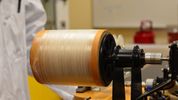A breakthrough experiment has pushed the limits of quantum physics to a mind-bending extreme, testing the GHZ (Greenberger-Horne-Zeilinger) paradox across 37 dimensions. Led by researchers in China, the team crafted a method that uses a fiber-optic photonic processor to test a quantum theory that challenges our everyday understanding of reality.
Their findings illuminate the deep, often bizarre nature of quantum interactions, offering new insights into the potential of quantum technology while simultaneously highlighting the limits of human intuition.
At the heart of the experiment lies the paradox of local realism — the concept that objects should exist in defined states that we can observe and deduce through causal chains. In the classical world, for example, if you check your mailbox, you can deduce if Aunt Judy sent you a birthday card and the how and why of its arrival. In quantum mechanics - the situation isn’t so clear-cut. Until you observe the system, events like whether or not a card is inside the mailbox remain in a "quantum superposition," meaning they are in multiple states at once, unresolved. This strange property, known as quantum entanglement, suggests that reality doesn’t always follow the logical rules we expect.
The GHZ paradox goes even further by predicting outcomes that appear to break local realism entirely. In an almost absurd scenario, it suggests that events can occur in multiple places at once, without any clear cause or logical connection. The Chinese team tested this using a simple quantum setup — just three "contexts" — to show that even with minimal components, quantum systems could display non-local behaviors. To make sense of these strange correlations, the experiment added a twist: 37 different spatial dimensions, far beyond our usual three-dimensional understanding of the world.
The results provide a deeper understanding of how the universe operates on a quantum level, but they also raise profound questions about the nature of reality itself. Why do we experience the world in such familiar, classical terms, while quantum mechanics seems to operate in a radically different way? And could these 37 dimensions point to new, untapped realms of physics?
A paradox at the heart of quantum physics has been tested in an extraordinary fashion, pushing the boundaries of human intuition beyond breaking point by measuring a pulse of light in 37 dimensions.
https://news.yahoo.com/news/quantum-experiment-reveals-light-existing-063418175.html
 unknownx500
unknownx500
















